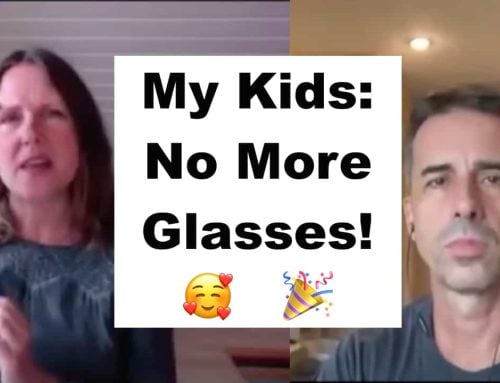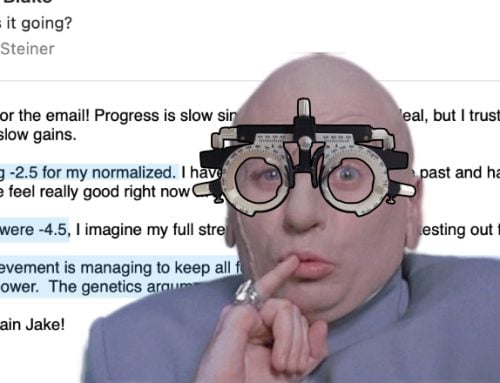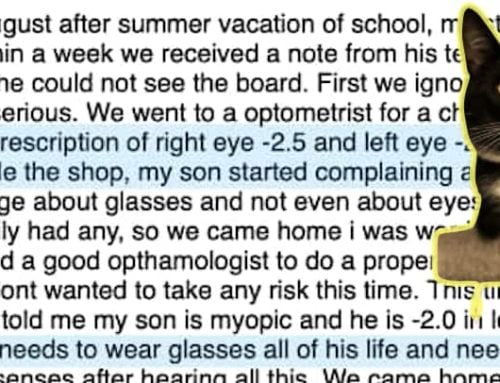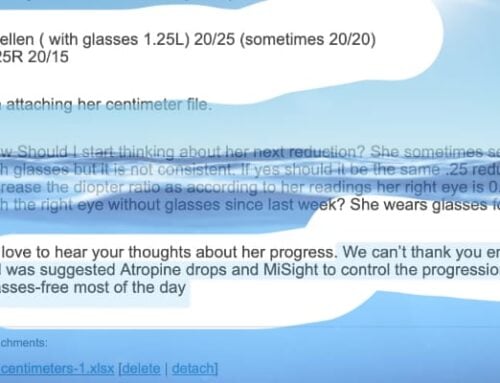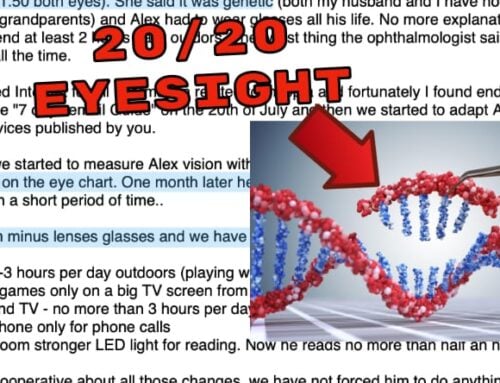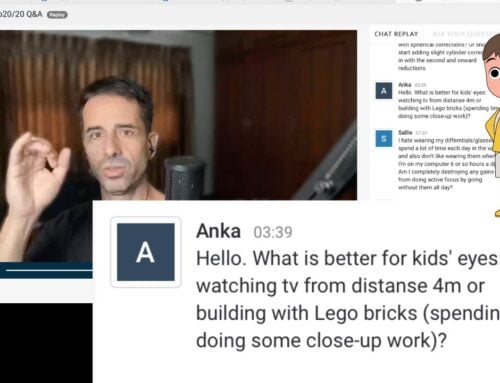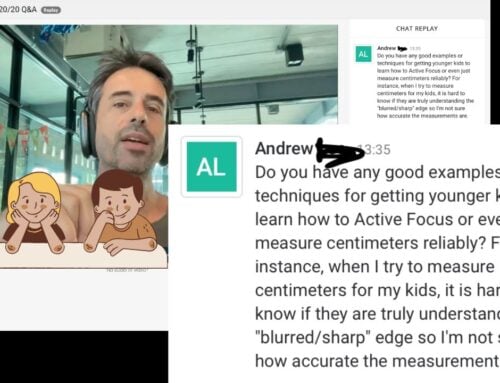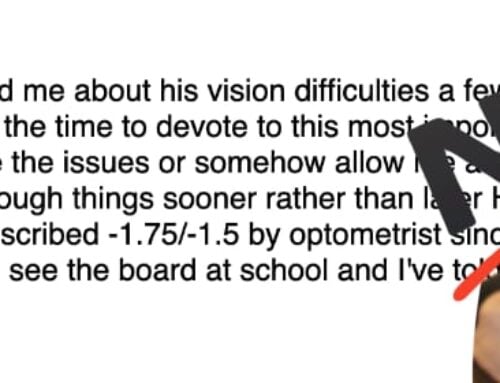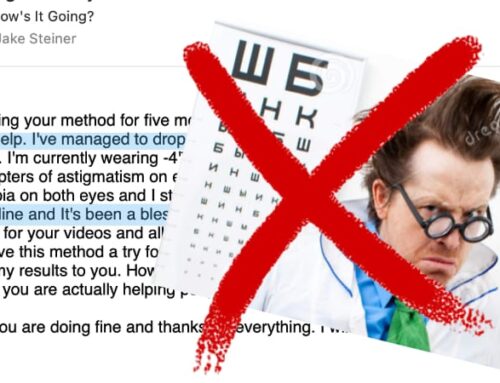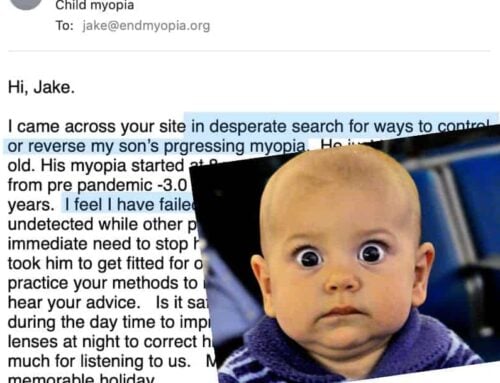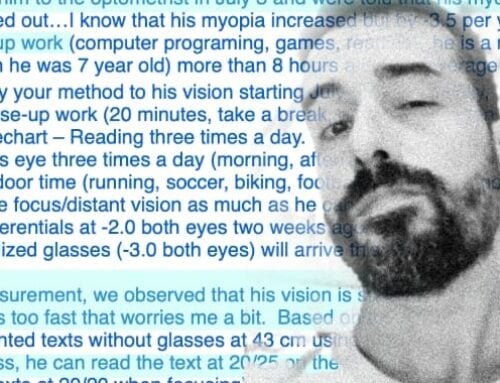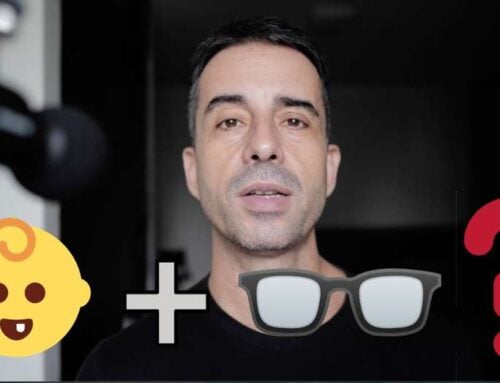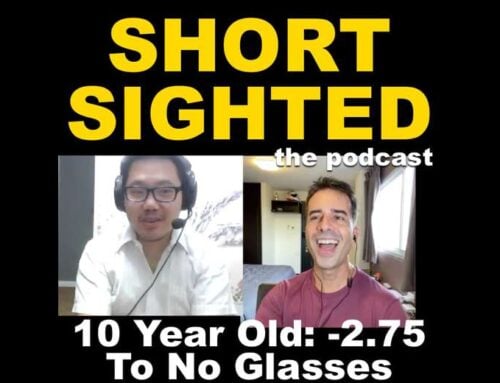Nate writes in the forum:
![]() I need some help with my 9 year old son. He has been complaining about not being able to see the chalkboard in school for about 6 months. I initially had him tested, and he tested at -1 diopter. I tried to teach him about taking breaks, good distance when reading, good habits, etc-I think he did some of them. I also tried to teach him to “pull focus” in the distance. For the last month, I’ve had him use plus lenses, and we read together and “push focus” every day for about 30 mins.
I need some help with my 9 year old son. He has been complaining about not being able to see the chalkboard in school for about 6 months. I initially had him tested, and he tested at -1 diopter. I tried to teach him about taking breaks, good distance when reading, good habits, etc-I think he did some of them. I also tried to teach him to “pull focus” in the distance. For the last month, I’ve had him use plus lenses, and we read together and “push focus” every day for about 30 mins.
Recently the teacher told us he is squinting a lot in class. He tells me he can read the chalkboard about 3/4ths of the time, and the other 1/4th he can’t.
I had him tested at the optometrist today-his prescription is: -1.0 od, -1.25 os.
I think he needs some glasses help to perform in school.
But what prescription should I get him for a “normalized prescription”.
How strong should I make his “differential prescription”.
I’ve been through the child myopia program very carefully. I just need a little help with the prescriptions.
—
There is so, so much of this that it would warrant an entire separate site, or at the very least significantly more work on the paid child program and child related blog articles. The whole myopia problem is a childhood problem, and the degree of the issue is quite unclear to many parents. The child’s eye is highly susceptible to stimulus and focal plane change, and you’re likely to see some very concerning results from young children and minus lens use.
In 2012 the results of a child myopia study were posted in AAO / Ophtalmology, which while not as conclusive as some of the others, is good in that it is both recent and succinct to a point I like to make often:
Get Your Kids Outdoors, Prevent Child Myopia!
It’s not just that, of course. I might also say take away the iPads and iPhones, and iAnything else as well. Nobody in the real world reads studies dealing with child myopia, so in the end the only thing you ever hear is glasses, or on the very fringes, some questionable alternative therapies. Let’s use one of these studies to help make my point about outdoor time.
Here’s what the study looked to assess:
Objective
To summarize relevant evidence investigating the association between time spent outdoors and myopia in children and adolescents (up to 20 years).
In other words, is there any point to Alex’ rantings about child free time use?
Results
The pooled OR for myopia indicated a 2% reduced odds of myopia per additional hour of time spent outdoors per week, after adjustment for covariates (OR, 0.981; 95% CI, 0.973–0.990; P<0.001; I2, 44.3%). This is equivalent to an OR of 0.87 for an additional hour of time spent outdoors each day. Three prospective cohort studies provided estimates of risk of incident myopia according to time spent outdoors, adjusted for possible confounders, although estimates could not be pooled, and the quality of studies and length of follow-up times varied. Three studies (2 prospective cohort and 1 RCT) investigated time spent outdoors and myopic progression and found increasing time spent outdoors significantly reduced myopic progression.
—
Some of the study details come up with figures, like 2% of myopia risk reduction per additional hour spent outside per week. I found the rationale a bit lacking in terms of the specific numbers to arrive at this conclusion, though it does present an easy incentive and soundbite for child myopia prevention.
If you want to use 2% as a figure, I’d offer another 5% reduction in myopia risk for every hour less spent playing games on handheld screens (not highly scientific, that number).
You also want to avoid the temptation of other quick fix ideas for child myopia, such as ortho. It’s on my list to eventually have a much more detailed article on that subject, which I have meanwhile been trying to avoid addressing. If you are tempted by ortho and have a myopic child, there is some emerging research suggesting that it’s not all roses like the sellers of the product suggest. As always, when the therapy is based on masking the symptom, we tend not to get very far.
Here’s the abstract of a study I liked for the title alone, Orthokeratology for myopic children: wolf in sheep’s clothing?
Orthokeratology attempts to reduce myopia by remoulding the corneal shape with contact lenses. A recent resurgence is predicated on new contact lens designs with a prefigured back contact surface and higher oxygen transmissibility. This Clinical Controversy presents an analysis of the risk factors associated with orthokeratology and its suitability for children, followed by commentaries from specialists who have an interest in the method. Some state that there is a lack of data on relative risks of corneal infection and that there is a need for large-scale randomized controlled studies; however, opinion is expressed by others that orthokeratology is a clinically safe procedure using modern lenses. It is noted that the physiological and biophysical bases of orthokeratology are virtually unknown, and further research on the human cornea is indicated to scientifically establish the safety of orthokeratology. Prospective patients, and their parents in the case of children, should be fully informed of the risks.
—
And yes, of course. Wolf in sheep’s clothing. Not much of a sheep though, mostly it’s make-lots-of-money in pipe-dream-for-parents clothing. Ortho makes money though, where not buying iPads and taking your children outside doesn’t. Also, taking them outside isn’t so easy with most parents work schedules and other obligations, making ortho and iPads a highly attractive proposition.
And thus the problem begins.
Here is what I suggest for Nate, in the forum:
![]() Well done on your efforts so far in correcting his myopia symptom.
Well done on your efforts so far in correcting his myopia symptom.
Are you making sure that he always has good distance from close-up reading? Smartphone and tablet games in particular can undo a lot of otherwise positive efforts.
A few things to consider:
Keep a log of his centimeter / Snellen results. These may well vary, but month over month you’ll want to be looking for any deterioration (and of course ideally, improvement).
If it were my child, I’d be looking for possible changes in the problem area, like sitting up a row further in school potentially, before I would go the minus lens route (since that is a notable setback). I’d be inclined to take out any sort of recreational close-up computer use for a few months, though not as punishment – possibly replacing with better distance such as playing games on a TV screen.
Realizing that 2-3 months can have a significant positive impact on a small degree of myopia in a young child, I would be looking at maximizing efforts for that short time, before possibly conceding to minus use.
I would potentially go so far as looking to replicate the distance / lighting type / blackboard scenario that happens at school, to be able to assess the problem at home. That, combined with Snellen results would help me see where my efforts are headed, and whether I can correct enough of the symptom to eliminate the immediate issue (of reading the blackboard).
A whole lot of this is psychological in terms of looking for success. If I can get him motivated and understanding that we can fix it now and not end up having to wear glasses (before he gets them and gets a taste of the quick fix of seeing clearly), then I have a better chance of fixing it now.
That, the ideal scenario.
On the other side, as I often tell clients, one has to look at the big picture. If circumstances or the child’s current disposition don’t allow for a full correction of the issue right now, sometimes we must concede. The most important thing is not to cast a negative emotional space around the whole subject of fixing eyes, with the child.
So if the age is more rebellious or tantrum prone or otherwise already challenging, I’d be looking to still minimize the close-up issue, and make sure that minus use is very limited. Ugly glasses, as a little secret sauce tip, can help with that one.
Maybe I have to wait a few months or a year or two before a window opens up when we can really work on improving eyesight. In this case I want to make sure that I preset the future to make my life easy later on – ie. minimal myopia increase due to low close-up strain, and minimal glasses use (because they are ugly, and because we learned to only use them when necessary).
As you know, myopia is very fixable – taking the time to map out the best scenario for long term success is key.
—
If I sold Ortho or glasses or Lasik, I’d have industry support and vendor support, and would be making easy money with lots of happy people enjoying being told that it’s not their fault and that the cure is a quick trip to their wallet.
Alas, it isn’t so. There’s the easy way, and there’s the right way. Nate deserves cudos for looking for a real fix, and his son is lucky to have him.
Enjoy some healthy eyesight today!


